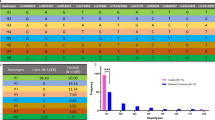Abstract
A systematic study of 42 Greek DMD/BMD families using 14 polymorphic markers that span the dystrophin gene was performed in order to assess the position and frequency of recombinants in the Greek population and to test whether “hot spots” of recombination and deletions coincide when exclusively studying DMD/BMD families. We report a low percentage of recombination between markers STR44 and STR50; otherwise, the distribution of recombination events in other parts of the gene is largely in agreement with previously published data on Centre d'Etude du Polymorphisme Humaine families. We therefore propose that recombination frequencies and the correlation between recombination and deletion “hot spots” should be evaluated on DMD/BMD families exclusively.
Similar content being viewed by others
Reference
Abbs S, Roberts TG, Mathew CR, Bentley DR, Bobrow M (1990) Accurate assessment of intragenic recombination frequency within the Duchenne muscular dystrophy gene. Genomics 7:602–606
Abbs S, Yau SC, Clark S, Mathew CG, Bobrow M (1991) A convenient multiplex PCR system for the detection of dystrophin gene deletions: a comparative analysis with cDNA hybridization shows mistyping with both techniques. J Med Genet 28:304–311
Chen JD, Hejtmancik JF, Romeo G, Lindlof M, Boehm C, Caskey CT, Kress W, Fischbeck KH, Dreier M, Serravalle S, Grimm T, Kaariainen H, Ferr M, Pfender E, Meng G, Chapelle A de la, Melis MA, Muller B, MacKinlay AG, Muller CR, Denton MJ (1989) A genetic linkage map of five marker loci in and around the Duchenne muscular dystrophy locus. Genomics 4:105–109
Clemens PR, Fenwick RG, Chamberlain JS, Gibbs RA, Andrade M de, Chakraborty R, Caskey CT (1991) Linkage analysis of Duchenne and Becker muscular dystrophies using dinucleotide repeat polymorphisms. Am J Hum Genet 49:951–961
Conneally PM, Edwards JH, Kidd KK, Lalouel J-M, Morton NE, Ott J, Write R (1985) Report of the committee on methods of linkage analysis and reporting. Human Gene Mapping 8. Cytogenet Cell Genet 40:356–359
Cooper DN, Krawczak M (1991) Mechanisms of insertional mutagenesis in human genes causing genetic disease. Hum Genet 87:409–415
Davies KE, Ball SP, Dorkins JR, Forrest SM, Kenwrick SJ, King AW, Lavenir IJD, McGlade SA, Patterson MN, Smith TJ, Wilson L, Paulsen K, Speer A, Coutelle C (1986) Molecular analysis of human X-linked diseases. Cold Spring Harbor Symp Quant Biol 50:337–343
Feener CA, Boyce FM, Kunkel LM (1991) Rapid detection of CA polymorphisms in cloned DNA: application to the 5′ region of the dystrophin gene. Am J Hum Genet 48:621–627
Florentin L, Mavrou A, Kekou K, Metaxotou C (1995) Deletion patterns of Duchenne and Becker muscular dystrophies in Greece. J Med Genet 32:48–51
Krawczak M, Cooper DN (1991) Gene deletions causing human genetic disease: mechanisms of mutagenesis and the role of the local DNA sequence environment. Hum Genet 86:425–441
Lathrop GM, Lalouel J-M, Julier C, Ott J (1984) Strategies for multilocus linkage analysis in humans. Proc Natl Acad Sci USA 81:3443–3446
Lathrop GM, Lalouel JM, Julier C, Ott J (1985) Multilocus linkage analysis in humans: detection of linkage and estimation of recombination. Am J Hum Genet 37:482–498
Nicholls RD, Fischel-Ghodsian N, Higgs DR (1987) Recombination at the human a-globin gene cluster: sequence features and topological constraints. Cell 49:369–378
Oudet C, Hanauer A, Clemans P, Caskex T, Mandel J-L (1992) Two hot spots of recombination in the DMD gene and correlation with the deletion prone regions. Hum Mol Genet 1:19–28
Ommen GJB van, Bertelson C, Ginjaar HB, Dunnen JT den, Bakker E, Chelly J, Matton M, Essen AJ van, Bartley J, Kunkel LM, Pearson PL (1987) Long-range genomic map of the Duchenne and Becker muscular dystrophy (DMD) gene: isolation and use of J66 (DXS268) a distal intragenic marker. Genomics 1:329–336
Roberts RG, Cole CG, Hart KA, Bobrow M, Bentley DR (1989a) Rapid carrier detection and prenatal diagnosis of Duchene and Becker mucular dystrophies. Nucleic Acids Res 17:811
Roberts RG, Montandon AJ, Bobrow M, Bentley DR (1989b) Detection of novel genetic markers by mismatch analysis. Nucleic Acids Res 17:5961–5971
Ruley HE, Fried M (1983) Clustered illegitimate recombination events in mammalian cells involving very short sequence hoologies. Nature 304:181–184
Yen PH, Li X-M, Tsai S-P, Johnson C, Mohandas T, Shapiro LJ (1990) Frequent deletions of the human X chromosome distal short arm result from recombination between low copy repetitive elements. Cell 61:603–610
Author information
Authors and Affiliations
Rights and permissions
About this article
Cite this article
Florentin, L., Bili, C., Kekou, K. et al. Mapping dystrophin gene recombinants in Greek DMD/BMD families: low recombination frequencies in the STR region. Hum Genet 96, 423–426 (1995). https://doi.org/10.1007/BF00191800
Received:
Revised:
Issue Date:
DOI: https://doi.org/10.1007/BF00191800



